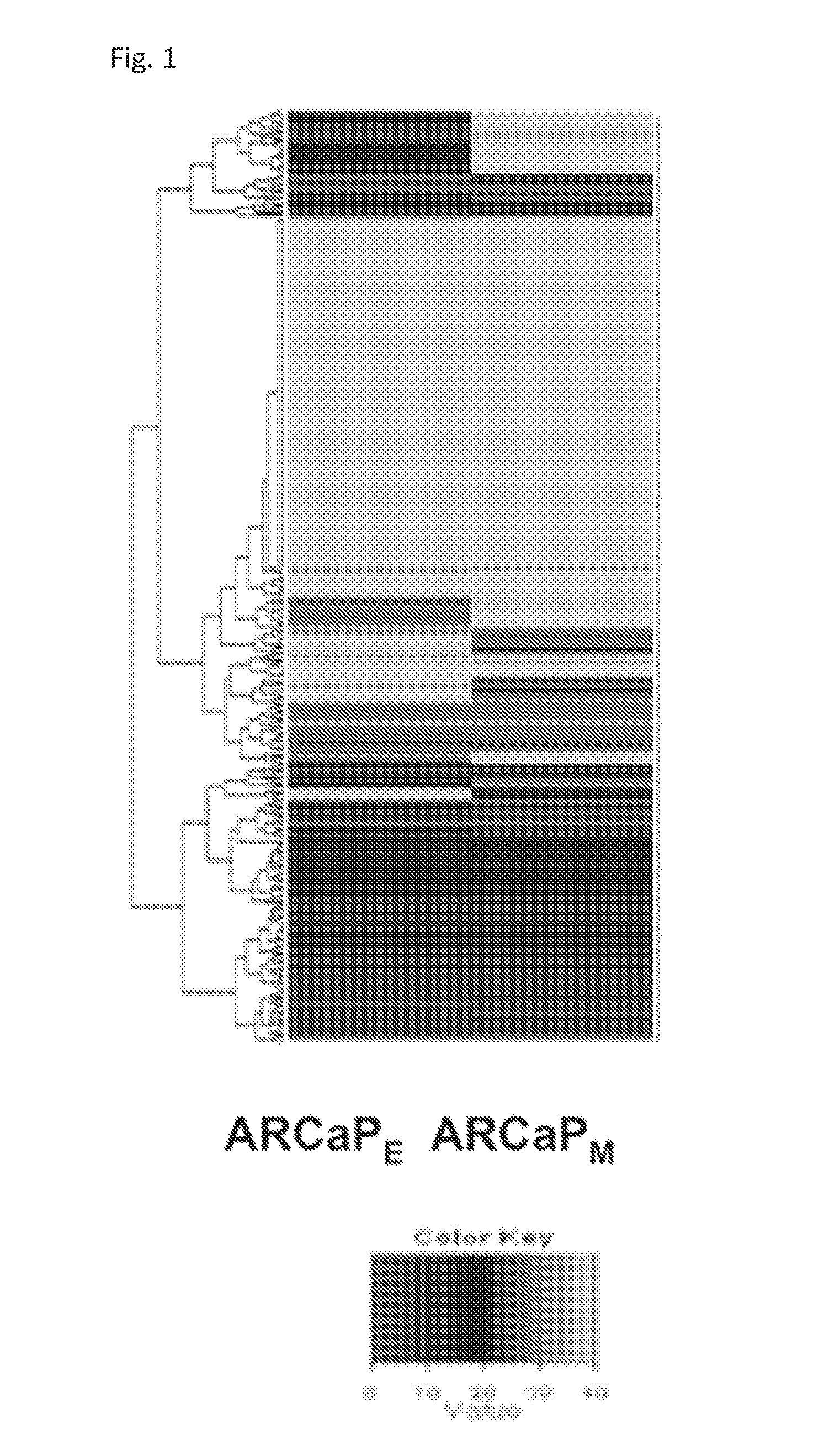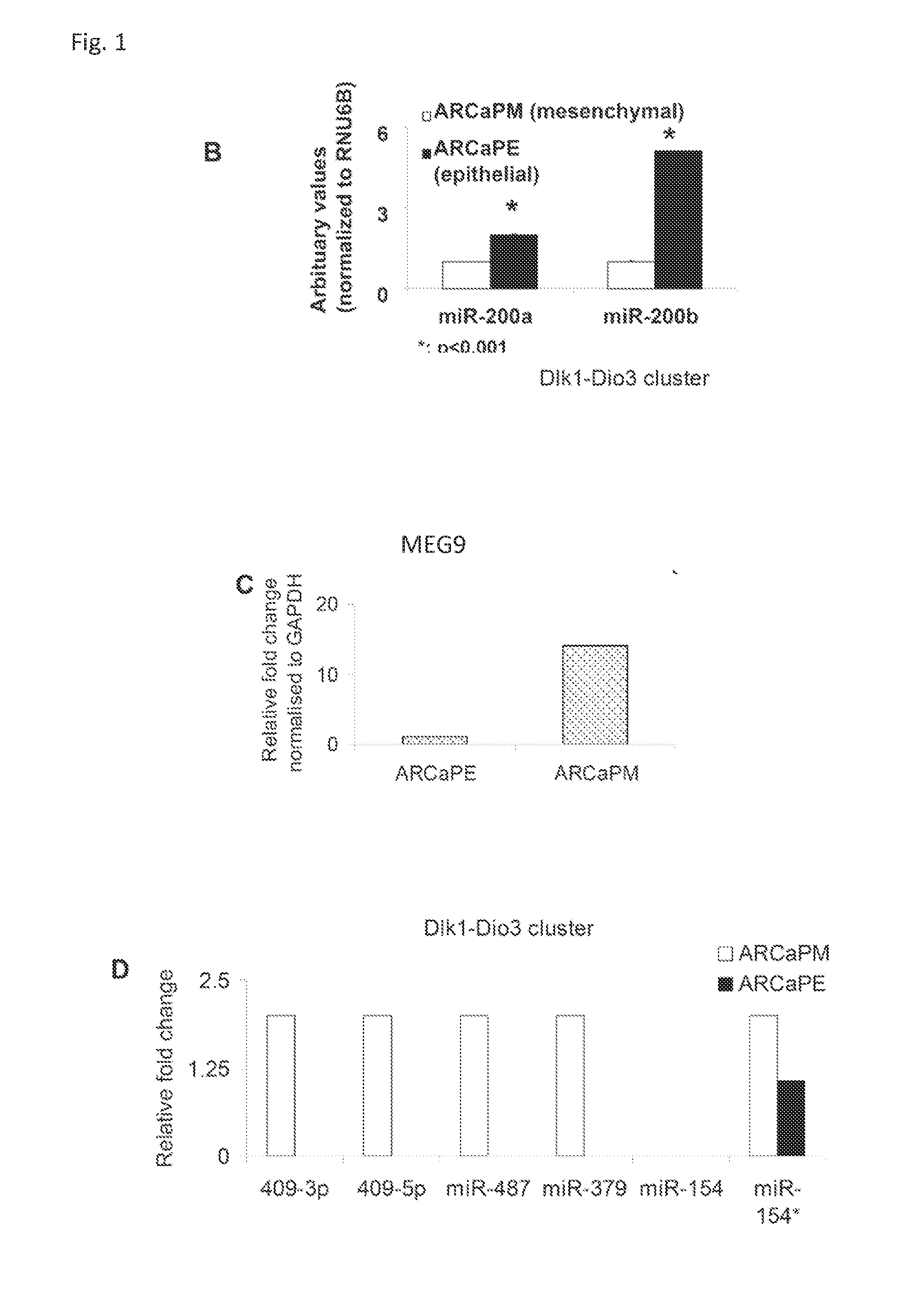Targeting micrornas mir-409-5p, mir-379 and mir-154* to treat prostate cancer bone metastasis and drug resistant lung cancer
a technology of micrornas and prostate cancer, applied in the field of micrornas and cancer, can solve problems such as ineffective treatment, and achieve the effects of reducing or steady expression level, increasing expression level of meg9, and reducing the likelihood of drug responsiveness
- Summary
- Abstract
- Description
- Claims
- Application Information
AI Technical Summary
Benefits of technology
Problems solved by technology
Method used
Image
Examples
example 1
MicroRNA Expression Profiling of Bone Metastatic Models of Prostate Cancer Reveal Elevated Expression of miR-409-5p
[0155]MiRNA profiling of two PCa bone metastatic cell based models derived from PCa patients, i.e. the human ARCaP model (ARCaPE and ARCaPM) (E-epithelial, M-mesenchymal), were performed (FIG. 1A) and the LNCaP model (LNCaP and C4-2) (15,16). The ARCaPE and LNCaP are less aggressive and do not metastasize to the bone, whereas the C4-2 and ARCaPM are highly aggressive and metastasize to the bone. Of these cell lines, miR-409-5p, miR-379 and miR-154* are upregulated in the highly bone metastatic ARCaPM cells (FIG. 1D). miR-409-5p is generated from immature transcript and transcribed form 5′ end of the pre-miRNA. The ARCaPM cells have 100% bone metastatic ability when injected intra-cardially into mice (17). The ARCaP model is an epithelial to mesenchymal transition model (17). Consistent with previously described EMT associated miRNAs, the miR-200 family members are highe...
example 2
Overexpression of miR-409 in Normal Prostate Gland Results in Tumor Growth
[0156]To test if miR-409 is oncogenic, the inventors injected human embryonic kidney, 293T cells transfected with miR-409 expressing lentiviral vector carrying green fluorescent protein (GFP) or control vector carrying GFP plasmid (System biosciences). The 293T cells were injected orthotopically into nude mice and tumor development was monitored using tumor specific infrared dye (IR783) (19). The rationale behind this procedure is that lentivirus will be secreted by the producer cells (293T) and infect prostate epithelia and stroma. Strikingly, tumors developed in three to five months in three out of four mice in miR-409 expressing prostates (FIG. 3A). The control mice did not develop tumors. The tumors had green fluorescence and showed tumor specific dye intake (FIG. 3A). Tumor sections were formalin fixed and paraffin embedded and H&E staining was performed. Tumor sections were graded by a pathologist. The t...
example 3
Inhibition of miR-409-5p in Mesenchymal Type Metastatic Prostate Cancer Cells (ARCaPM) Results in Cell Death, Upregulation of miR-409-5p Target Genes (Tumor Suppressors) and Reversion of Epithelial to Mesenchymal Transition (EMT to MET)
[0157]Inhibition of miR-409-5p using a lentiviral based anti-miR-409-5p resulted in significant cell death of metastatic prostate cancer cells (FIG. 4A). miR-409-5p expression was decreased in ARCaPM cells stably transfected with miR-409-5p inhibitor construct compared to control. miR-409-5p target mRNAs including TUSC4, PHC3 and STAG2 were evaluated and these were increased in miR-409-5p knockdown cells (ARCaPM-409-5pi) metastatic prostate cancer cells compared to the ARCaPM control (ARCaPM-C) cells. TUSC4 is a tumor suppressor protein deleted in solid tumors. PHC3 is part of the polycomb group proteins involved in transcriptional repression and regulation of cell fate (20). The siRNA-mediated down-regulation of TUSC4 induced cell proliferation, whil...
PUM
| Property | Measurement | Unit |
|---|---|---|
| Electrical resistance | aaaaa | aaaaa |
Abstract
Description
Claims
Application Information
 Login to View More
Login to View More - R&D
- Intellectual Property
- Life Sciences
- Materials
- Tech Scout
- Unparalleled Data Quality
- Higher Quality Content
- 60% Fewer Hallucinations
Browse by: Latest US Patents, China's latest patents, Technical Efficacy Thesaurus, Application Domain, Technology Topic, Popular Technical Reports.
© 2025 PatSnap. All rights reserved.Legal|Privacy policy|Modern Slavery Act Transparency Statement|Sitemap|About US| Contact US: help@patsnap.com



